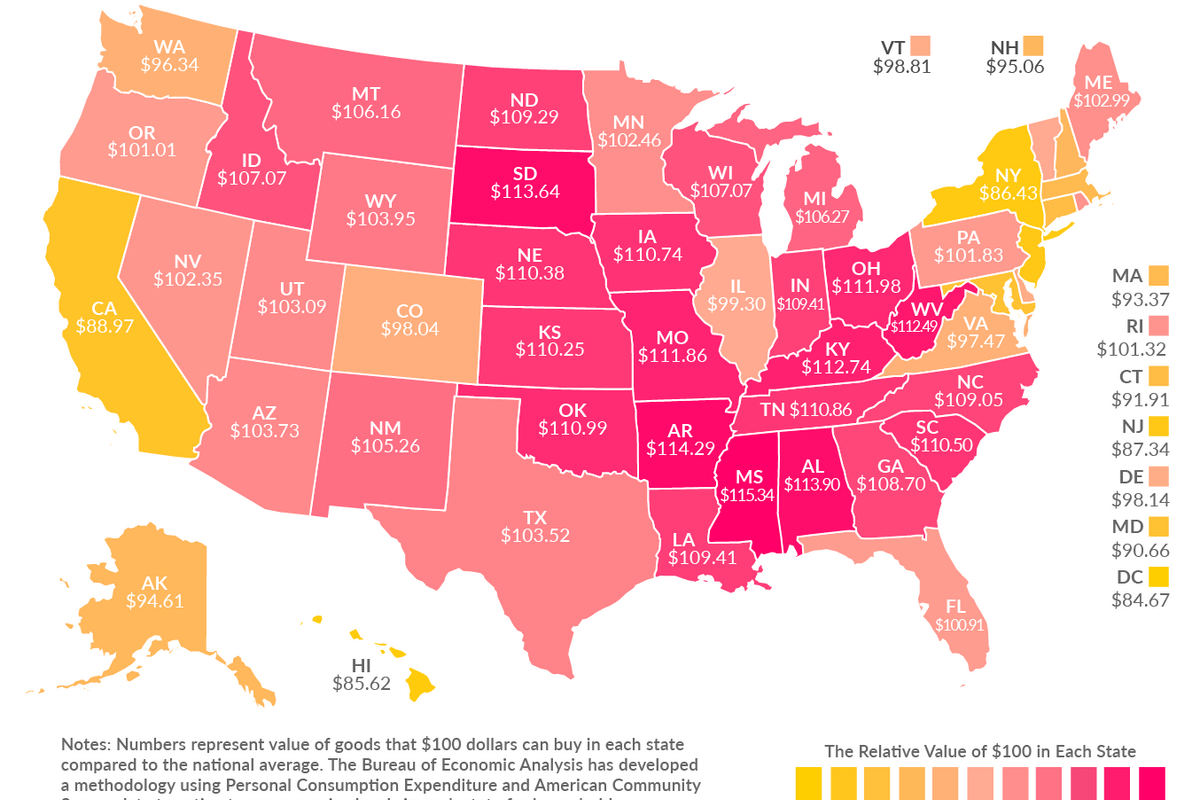How far does $100 go in your home state?
Loading...
Are the residents of Nebraska richer than those of California? By some measures, yes. One hundred dollars in the state is really worth $110.38, according to "The Real Value of $100 in Each State," a new analysis from the Tax Foundation. Out of all US states, Nebraska ranks 13th when it comes to the affordability of some taxes, rent, groceries, and services. Such expenses are 10 percent cheaper there than the national average.
In California, on the other hand, where expensive land leads to high rents that lead to higher-costing good and services, $100 buys residents only $88.97 worth of things like milk and accounting services. That puts the state at 47th place in the Tax Foundation's ranking, ahead of only New Jersey, New York, Hawaii, and the District of Columbia.
Californians have to earn 24 percent more per year to afford the same standard of living as Nebraskans, but they don’t. Residents of the two states earn nearly the same amount of money per person on average, so their nominal income is almost the same. But the residents of the midwestern state can buy more. After adjusting for their purchasing power, Nebraskans have a higher average income than Californians, says Alan Cole, an economist with the Tax Foundation, a Washington-based think tank and advocacy group.
This has implications for progressive income-tax policy, which taxes the seemingly wealthy at higher rates than the apparently poor, writes Mr. Cole in a recent analysis.
In it, Cole examines data released in July by the Bureau of Economic Analysis (BEA), a federal agency that for the past two years has collected and compared statistics on incomes and prices in US states and metropolitan areas. Taking prices into account when looking at average incomes in the states can change the whole picture of who’s rich and poor, Cole found.
“One thing you can wonder about is if progressive federal income tax is sending a lot of money from California to Ohio, maybe it’s doing a little too much of that,” Cole tells The Christian Science Monitor. Ohio is rated #7 on Tax Foundation’s ranking.
Cole suggests that considering only people’s nominal income for tax purposes, or when deciding who is eligible for government subsidies, is shortsighted. He also raises the question of whether a single, federal minimum wage is wise, given the cost-of-living differences among the states.
“We’re probably underrating states like Ohio, and overeating places like the Bay Area in terms of their means,” he says.
Of course, employers in expensive cities and metropolitan areas pay more to compensate their workers for the high cost of living near work. In these places that are considered rich, prices tend to rise. They do so because a scarcity of land in crowded urban areas, causes prices not only for rent to soar, but also for groceries and electronics. Stores have to pay higher rent in New York City than in Biloxi, Miss., for example.
There are exceptions, Cole points out. North Dakota, home to the oil and gas industry, had a high average income but cheap prices in 2014, the year BEA's data was compiled, thanks to a wide availability of land. That was before oil prices went in to free fall and the local economy took a hit, but for $100, North Dakotans got $109.29 worth of value -- 23 percent more than Californians.
“If nominal incomes were perfectly correlated with price levels, than every state would be doing the same,” Cole says. “Obviously that’s not quite true; we know that there are well-off areas and distressed areas.”
Despite how much things cost from state to state, everyone is earning more these days, according to the BEA. On a nominal basis, personal income across all regions grew an average of 4.4 percent in 2014, inching closer to the 5 percent of annual growth common before the Great Recession of 2008.
“2014 overall was a pretty good year,” Cole says.







